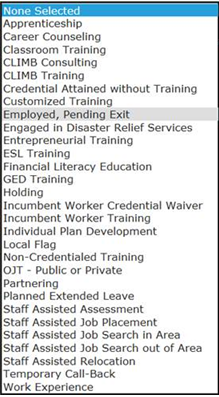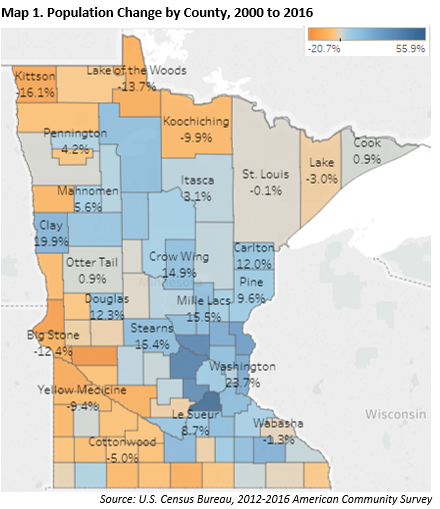TAA Update:
TAA On-the-Job-Training Partnership
While
in Grand Rapids, MN to meet with workers affected by layoffs from Blandin Paper
Company, TAA staff connected with Grand Rapids Area Chamber of Commerce
President and NE MN Workforce Development Board Chair, Bud Stone. Bud explained
many employers in that region are wanting to hire the laid off workers with the
intent to train them internally. TAA staff provided details about the
On-the-Job-Training (OJT) benefit under TAA. Bud and TAA talked about the
challenge of connecting the employers to the eligible job seekers. As a
solution to this challenge, Bud offered to assist by sending TAA’s cover letter
about OJTs [pdf attached] to his regional contacts and businesses. He also
volunteered to keep a list of employers that express interest in OJTs, and
invited TAA-eligible job seekers to contact him for the list of interested
employers. See the related Herald-Review article here [pdf]. Thank you to
the Grand Rapids Chamber of Commerce for partnering with TAA! We look forward
to many OJT success stories coming from this region. Please feel free to share
the attached cover letter with your Chamber of Commerce and/or other contacts
to raise awareness about the OJT benefit through the TAA program.
Grant Updates:
2018 Minnesota Job Skills
Partnership Board Meeting Schedule and Supplemental Funding Request Deadlines
The Minnesota Job Skills Partnership (MSJP) Board voted on
October 30, 2017 to adopt proposed revisions to DEED’s Requests for
Supplemental Funding to Serve Small Layoffs policy. The new policy is can be
found at https://apps.deed.state.mn.us/ddp/PolicyDetail.aspx?pol=475,
along with the Supplemental Funding Request Workbook. If you are interested in
requesting additional small layoff funding, please email Chelsea Georgesen
(Chelsea.s.georgesen@state.mn.us) the completed workbook along with a written
narrative that includes the total amount of funding requested, total number of
participants to be served, and addresses the following statutory requirements
when available
and applicable:
- The number of substantial layoffs to date,
- Notices of substantial layoffs for the remainder
of the fiscal year,
- Evidence of declining industries,
- The number of permanently separated individuals
applying for unemployment benefits by workforce development area (if
available), and
- The number of individuals exhausting
unemployment benefits by workforce development area (if available)
The narrative can be concise and
should typically require 1-2 pages of information.
MJSP Board meeting dates and
supplemental funding submission deadlines for 2018 are:
- Monday, March 12, 2018
-Supplemental funding requests due
to DEED staff by Monday, February 12, 2018
- Monday, June 18, 2018
-Supplemental funding requests due
to DEED staff by Monday, May 21, 2018
- Monday, October 29, 2018
-Supplemental funding requests due
to DEED staff by Friday, September 28, 2018
- Monday, December 10, 2018
-Supplemental funding requests due
to DEED staff by Monday, November 12, 2018
NEW! “Employed, Pending
Exit” Activity in Workforce One
We received feedback from
providers that it would be helpful to have an activity in Workforce One that shows
that a participant has obtained a new job, but is not yet exited from the
program because their last date of service has not yet reached 90 days. As a
reminder, DEED’s exit policy states that “the term program exit means a participant has not received a service
funded by the program or funded by a partner program for 90 consecutive
calendar days, and is not scheduled for future services.” In other words, a
person is not formally exited from the program until 90 days after they
received their last service and the exit date out of the program is retroactive
to the date of that last service.
Due to this backdating requirement the Workforce One team has created a new
activity called “Employed, Pending Exit” for you to use after your participant
tells you they obtained a new job. This new activity will allow you to
accurately capture your participant’s case status instead of needing to keep
other types of activities open.
 How to use the new
activity
After your participant informs you of their newly obtained employment:
- Open the “Employed, Pending Exit” activity in
your participant’s Workforce One record. Use the date you received employment
details from your participant as the activity start date.
- Close all other open activities; use the start
date of the “Employed, Pending Exit” activity as the close date for all other
open activities.
- Enter a tickler to remind yourself to exit the
case in 90 days.
If your participant receives a service after the
“Employed, Pending Exit” activity is already open:
- Change the start date of the “Employed, Pending
Exit” activity to the new day of the last service
- Edit your tickler to the new 90 day countdown
30 day communications between
participants and case managers are no longer required by DEED after the
“Employed, Pending Exit” activity is activated and during its related 90 day
holding period. However, your provider may have additional requirements
outlined in their local policies, so please continue to follow local policies
with respect to live contact and other follow up/exit procedures.
Requests for SFY17 Success
Stories
The Dislocated Worker Program is currently preparing its
SFY17 Annual Report, due to the legislature by March 1, 2018. We are looking
for success stories for Dislocated Worker participants to help highlight some
of the incredible work our partners do every day. If you are interested in
submitting a success story for possible inclusion in the report, please
complete and sign the attached Consent to Share Information form and include a
photograph of the participant and their story with a particular eye to how they
were impacted by:
- Career Planning & Counseling
- Job Training & Placement Services
- Financial Support Services
- Community Resources and Partnerships
- DW Selection Committee (tell us if a participant
volunteered with this process)
Thank you for your help and for your continuing commitment
to serving laid off workers!
Performance Updates:
Measurable Skill Gains
Reminder
If you have a participant attending training remember to enter at least
one Measurable Skill Gain (MSG) into Workforce One (WF1) every fiscal year in
which that participant is attending training. If MSGs are not entered every
fiscal year it will have a negative impact on performance outcomes.
Differences between training
related performance indicators
o
MSGs are
captured in WF1 while the participant is attending training. (see below
instructions)
o
Credentials
are captured within the “Credential” tab of WF1 after the participant finishes
training.
MSG Definitions
o
Educational
Functioning Level: Documented
achievement of at least one educational functioning level of a participant who
is receiving instruction below the postsecondary education level;
o
Secondary
or Post-Secondary Transcript:
Secondary or postsecondary transcript or report card for a sufficient number of
credit hours that shows a participant is meeting the State unit’s academic
standards;
o
Training
Milestone: Satisfactory or
better progress report, towards established milestones, such as completion of
OJT or completion of one year of an apprenticeship program or similar
milestones, from an employer or training provider who is providing training; or
o
Skills
Progression: Successful
passage of an exam that is required for a particular occupation or progress in
attaining technical or occupational skills as evidenced by trade-related
benchmarks such as knowledge-based exams.
How to enter MSGs in WF1
1.
Log into
WF1
2.
Hover
over “Search” in the top panel
3.
Click on
“Person”
4.
Search
for your participant then click on their name
5.
Once in
the participant’s case
- Click on “Reporting Collection” within the
side panel of the record
- Click on “Edit” within the Action column
- Click on “Add New Measurable Skill”
- Select the accurate “Measurable Skill Type”
related to the documentation received from your participant (make sure to keep
a copy for the case file)
-Educational Functioning Level
-Secondary or Post-Secondary Transcript
- Training Milestone
-Skills Progression
- Enter the “Attainment Date” your participant
received the gain
- Click “OK”
6. All
captured MSGs for the participant’s program enrollment are viewable in the
“Reporting Collection” screen (most recent on bottom)
7. All
captured MSGs can be edited and/or deleted by the assigned case manager
 Corner On The Market
With Cameron Macht
Regional Analysis & Outreach Manager
Minnesota Dept. of Employment & Economic Development
cameron.macht@state.mn.us
320-441-6596
|
The Changing Faces of Minnesota
The U.S. Census Bureau released the most recent 2012-2016
American Community Survey 5-year estimates on December 7, 2017, providing
updates to many detailed tables for every county and place in the state and the
region. This included new estimates on population
trends, demographic
shifts, and social
and economic
characteristics.
According to the new data, Minnesota was home to just over 5,450,000
residents in 2016, an increase of more than 530,000 additional residents since
the turn of the century. Well over half of the 87 counties in the state were
seeing population gains, with the fastest growth stretching from the
Fargo-Moorhead area through St. Cloud to the Twin Cities metro area and down to
Rochester and Mankato.
After expanding 55.9 percent, Scott County remained the fastest growing
county in the state, followed closely by other metro fringe counties including
Wright, Sherburne, Carver, Chisago, Washington, and Isanti, which all grew more
than 20 percent from 2000 to 2016. In sum, 24 counties grew faster than 10
percent since 2000, and 49 of the state’s 87 counties saw some growth (see Map
1).
 In contrast, 38 counties in the state saw population declines. Most of
these counties were located along the western and southern border of the state,
and tended to be more rural and already had relatively small populations. Nine
counties lost more than 10 percent of their population from 2000 to 2016, led
by Swift County, which suffered larger population loss due to the closing of a
correctional facility.
Despite the population declines, the new
data show that even in these smaller, rural counties Minnesota’s population
was growing more diverse, with the number of residents from different race
groups and ethnicities increasing rapidly since the turn of the century. While
the number of white residents in the state grew by 4.5 percent, representing a gain
of nearly 200,000 people; the number of people of other races rose much more
rapidly.
The number of Black or African American residents nearly doubled in
Minnesota from 2000 to 2016, a gain of over 139,000 additional people. The state
also added 105,000 Asian residents, almost 66,000 more people of two or more
races, 22,500 people of some other race, and just under 2,000 additional
American Indians. But the fastest growth occurred in Minnesota’s Hispanic or
Latino population, which also almost doubled to more than 275,000 people through
2016, now accounting for about 5.1 percent of the state’s total population (see
Table 1).

Map 2. Share of Population that is Hispanic or Latino by County, 2016
 The state’s American Indian population was more strongly concentrated
in northern Minnesota, led by Mahnomen and Beltrami County. The Twin Cities was
home to the largest Black or African American and Asian populations. More
information on the geographic location of the state’s different race and origin
groups from the 2012-2016 American Community Survey 5-Year Estimates is
available using this interactive map: https://public.tableau.com/profile/magda.olson#!/vizhome/PopulationbyRace2016/Map1
Success Story
 Anna, Career Solutions (Stearns and Benton Counties)
Anna lost her job as a PRIDE Specialist with
Independent Lifestyles, Inc. Being
separated from her employment was devastating because it was a job she enjoyed,
believed in, and intended to stick with long-term. In reflecting upon her time in the Dislocated
Worker Program Anna said the services that were most beneficial for her was the
one-on-one guidance on how to set up her resume and utilize other job search
tools. She was also grateful for the
assistance she received on her cover letter, reference list, interview tactics,
letters of recommendation and LinkedIn page, which helped her market herself to
employers. When asked how she has
changed throughout and following the completion of the program, Anna said she
feels “more confident about her resume and employment history. My experience
resulted in getting a higher paying job as a Mental Health Adult Case Manager
with a great company the Central Minnesota Mental Health Center, with better
benefits and opportunity for growth and advancement.” She said she would definitely recommend the
Dislocated Worker Program to other workers who lose their jobs.
|
UNIT DIRECTORY
May Thao Schuck
Interim Director
651-259-7563
may.thao.schuck@state.mn.us
DW LINE
651-259-7537
RAPID RESPONSE
MARLA BEATY
(TAA LIAISON)
218-259-1380
MO MALIN
651-259-7535
LIZ MCLOONE
(LABOR LIAISON)
651-259-7145
JASON WADELL
651-259-7552
GRANTS
CHELSEA GEORGESEN
(GRANTS & POLICY COORDINATOR)
651-259-7508
MONICA WEBER
651-259-7560
PERFORMANCE
AMY CARLSON
651-259-7542
General TAA Contact
651-259-7543
1-888-234-1330
deed.taa@state.mn.us
TAA TEAM
JENNIFER ANDERSON
651-259-7690
CINDY BOYLE
(CO-COORDINATOR)
651-259-7551
MARY GARCIA
651-259-7553
ESTELA HERNANDEZ
651-259-7501
LAURIE LARSON
651-259-7681
SARAH SAITO
(CO-COORDINATOR)
651-259-7546
LINDA SKOGEN
651-259-7588
THOMAS SOMMER
651-259-7585
JACKIE UMLAUF
218-739-7560
OLAJIDE WILLIAMS
651-259-7431
Trade Readjustment Allowance
651-296-3644 ask for a TRA Specialist
877-898-9090 ask for a TRA Specialist
deed.tra@state.mn.us
We want this e-Newsletter to meet your needs! We encourage you to send your comments and suggestions to Liz.McLoone@state.mn.us,
Find past issues of Partner's Express here.
Wanting to subscribe to this newsletter? Contact Liz McLoone at Liz.McLoone@state.mn.us with your request!
|